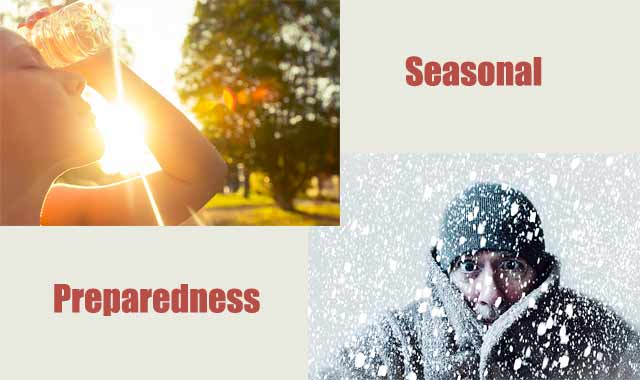Preparing For Seasonal Considerations Without Heat or AC
Level 1 Prepping & Preparedness
Important for prepping and preparedness are the seasonal extremes and other conditions which I will describe in a minute.
We sure have it made in our modern world of heat and air-conditioning. We can spend most of our time in climate controlled homes, offices, stores that we shop, our vehicles…
But for those who live where it can get really cold or really hot, you better give a bit of thought to what you would do if our modern “lifeblood” were to temporarily go away (electricity).
No heat during the winter? No air-conditioning during the summer?
It could even become life threatening.
It’s all about body core temperature and seasonal considerations. Although ANY season could present issues if you’re not properly prepared for it.
While Level-1 preparedness is intended for disruptions lasting hours, days, or maybe up to a week, it won’t take long for your house to get mighty cold during the winter or really hot during the summer.
The good thing is that this level of preparedness presumes that you could potentially drive out of it. However let’s say you’re stuck at home during a snowstorm and the power goes out? Pretty difficult to drive out of that one… Get the idea?
Staying Warm In The Winter
Again, if the power goes out, so does your furnace. Sure a wood stove would solve that problem, but if you don’t have one, what will you do?
One option that I’ve written about before is a portable propane heater that’s safe for indoor use (with common sense cautions and caveats). It’s the “Heater Buddy”. I have this and actually use it downstairs in the tool room during those extra cold winter days. It’s a great little portable room heater.
Here’s an article on it:
‘Mr. Heater Buddy’ for Winter Survival Preparedness
Here’s another thought: A decent wool or fleece blanket to keep warm:
[ Read: The Warmest Survival Blanket – Wool Or Polar Fleece? ]
Have you thought about winter preps that stay in your vehicle? Since we are so often in our vehicles or it’s accessible to us while at work, it makes it a good place to keep some preps for just in case.
[ Read: Winter Preps To Keep In Your Car ]
Staying Cool In The Summer
Admittedly I do not have lots of experience in HOT weather climates. I live up in the north although it gets darn hot during the summer even up here.
That said, one of the best suggestions I can think of is to STAY HYDRATED. Drink lots of water. It is surprisingly easy to become dehydrated, and it can even lead to dangerous health conditions.
[ Read: Dehydration Symptoms, Prevention ]
Some say that seventy-five percent of Americans are chronically dehydrated. Now couple that apparent statistic with a very hot environment with no air-conditioning.
During the summer when it’s extra hot while I am working outside and sweating / dehydrating, I use Vitalyte electrolyte powder and mix with water. This stuff really works.
Vitalyte Natural Electrolyte Powder Sports Drink Mix
(view on amzn)
Here’s an article I wrote awhile ago: Heat Stroke And Avoidance
Other ideas include the following:
Open windows at night and close them in the morning to help keep the cooler air inside. It may seem counter-intuitive but even though it may feel warm in the house, if it’s hotter outside, keep the windows closed.
That said, moving-circulating air is wonderful. It helps evaporate the moisture on your skin and makes you feel cooler. But how do you do that without electricity?
One way is with a battery operated fan. I don’t have this one, but it looks interesting. Easily portable, recharge via USB, and it could be used with one of those USB external battery storage devices for longevity before need for recharge (I do have one of those).
Mini Rechargeable Clip on Table Fan
(view on amzn)
Anker 10000mAh External Battery
Hypothermia
The condition of hypothermia can happen not only in the winter but also the summer! Encountering a summer rain and temperature drop while not dressed properly can lead to rapid chilling of the body, shaking, and even hypothermia.
Hypothermia is a life threatening condition in which deep-body core temperature falls below 95°F (normally it’s 98.6°F).
More commonly we hear about it relating to cold weather conditions.
A key to preventing it is to dress in layers. Have outerwear that’s purposed towards the environmental conditions.
[ Read: How To Prevent Frostbite, Hypothermia ]
Again, we are used to our climate controlled environments. But you should consider your options if that went away.
You might consider keeping extra seasonal-related clothing and outwear gear in your vehicle. Even just a sweater or sweatshirt, an extra jacket or raincoat. Extra protection in case you need it.
SUMMARY
All I’m saying here is to consider this category (seasonal considerations) even for your Level-1 preparedness.
Think of it with regards to your home environment and dependencies upon electricity. How does it relate to what you keep (or should keep) in your vehicle. Your outdoor adventures or activities can also fall victim to weather extremes.
Your body core temperature can get too HOT and it can get too COLD.
Both conditions can be very dangerous.
[ Read: Preparedness Level 1 – 4 Series Overview ]

